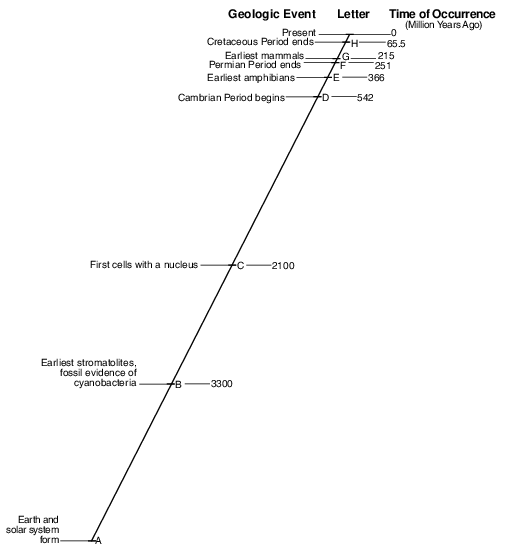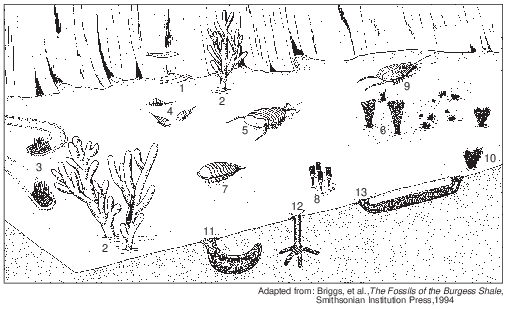Topic: Evolution Of Life Forms And The Free Oxygen In The Atmosphere
Evolution Of Life Forms And The Free Oxygen In The Atmosphere
Which conclusion can be drawn from the pattern of fossils found in Earth’s rock record?
(1) Humans have existed for a longer period of time than dinosaurs.
(2) Complex land organisms have been replaced by simpler marine forms.
(3) Many species have existed in the past, and most have become extinct.
(4) Few life forms existed before the late Cretaceous period.
Which geologic event occured in New York State at about the same time as the extinction of dinosaurs and ammonoids?
(1) formation of the Queenston Delta
(2) deposition of the sands and clays underlying Long Island
(3) initial opening of the Atlantic Ocean
(4) advance and retreat of the last continental ice sheet
When did the earliest humans appear on Earth?
(1) before the earliest dinosaurs
(2) before the earliest flowering plants
(3) during the Pleistocene Epoch
(4) during the Late Triassic Epoch
The timeline below represents time on Earth from the beginning of the Paleozoic Era (A) to the present (B).

Which numbered position best represents the time when humans first appeared in the fossil record?
(1) 1
(2) 2
(3) 3
(4) 4

Organism A is a labyrinthodont and is most likely classified as
(1) a mastodont
(2) an amphibian
(3) a dinosaur
(4) a mammal
Which group of organisms survived mass extinctions that marked the ends of both the Paleozoic Era and the Mesozoic Era?
(1) ammonoids
(2) graptolites
(3) eurypterids
(4) gastropods
Examination of the fossil record shows a general tendency of organisms to become increasingly more complex through geologic time. This finding supports the theory that living things have undergone
(1) metamorphism
(2) evolution
(3) radioactive decay
(4) mass extinctions
The change in life-forms in the fossil record from less complex organisms to more complex organisms over time is best explained by
(1) extinction
(2) evolution
(3) dynamic equilibrium
(4) original horizontality
During which geologic period did plants and animals first appear in land environments?
(1) Cambrian
(2) Ordovician
(3) Silurian
(4) Devonian
What is the approximate percentage of Earth’s history during which humans have existed, compared to the age of Earth?
(1) 0.04%
(2) 1.79%
(3) 4.65%
(4) 8.32%
A timeline from the origin of Earth until the present is shown below.

At which letter on the timeline did the Ediacaran fauna exist?
(1) A
(2) B
(3) C
(4) D

Identify the two consecutive letters on the timeline that represent the time span within which the earliest insects appeared on Earth. [1]
___________ and ___________
Allow 1 credit for D and E.

Identify the names of the two index fossils found in these rock layers that represent organisms that could have been alive at the same time. [1]
________________________________ and _________________________________
Allow 1 credit for Cryptolithus and Valcouroceras.
• Note: Do not allow credit for B and D because these are not the names of the fossils.
Dinosaur Skull Offers Hints About Africa’s Past
A fossil skull was found in Africa among many dinosaur bones from the Late Cretaceous Epoch. This skull came from a dinosaur named Rugops primus, or “first wrinkle face.” This meat eater, believed to have been about 30 feet long and to have lived 95 million years ago, belonged to a group of dinosaurs called abelisaurids.
This fossil skull, unearthed in the Sahara Desert in 2000, provides new evidence that Africa split from other southern continents at a later time than previously thought. Before this discovery, abelisaurids from that period had been found only in South America, Madagascar, and India, but not in Africa. This new fossil, Rugops primus, found only in Africa, indicates that Africa was still connected to the other southern landmasses, at least by a land bridge, 100 million years ago.
During which geologic era is Rugops primus inferred to have lived? [1]
Era
Allow 1 credit for Mesozoic Era.
Burgess Shale Fossils
The Burgess shale fossil discovery revealed unique Cambrian life-forms, most of which were not present in the previously known fossil record. Normally, soft body parts of dead organisms are destroyed by scavengers and bacteria on the ocean floor. However, in the deep-water depositional environment of the Burgess shale, oxygen was lacking and organisms were buried rapidly, preserving the unique community seen in the diagram. The soft-bodied organisms had previously been unknown. The Burgess shale fossils were originally found in a layer of bedrock in southwestern Canada.

Identify the number of one organism in the diagram that is most likely a trilobite. [1]
Allow 1 credit for 4, 5, 7, or 9.
